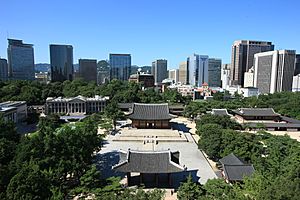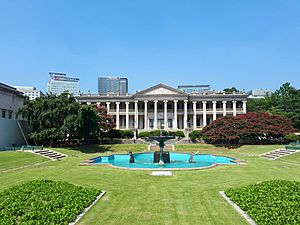Deoksugung facts for kids
| Deoksugung | |
 |
|
Quick facts for kids Korean name |
|
|---|---|
| Hangul | |
| Hanja | |
| Revised Romanization | Deoksugung |
| McCune–Reischauer | Tŏksugung |
Deoksugung (pronounced Deok-soo-goong) is a famous palace in Seoul, Korea. It's also known as Deoksugung Palace or Deoksu Palace. This special place was once home to the Royal Family of the Joseon kingdom. They lived here until Korea was taken over by Japan in 1910.
Deoksugung is one of the "Five Grand Palaces" built by the Joseon kings. It's now a Historic Site. The palace has many different kinds of buildings. Some are made of natural wood, others are painted wood or stucco. There are even stone buildings that look like Western palaces!
Besides the traditional palace buildings, you can find beautiful gardens. There's also a statue of King Sejong the Great, who invented the Korean alphabet. The National Museum of Art is also here, showing special exhibits. The palace is easy to reach, located near City Hall Station.
Like other grand palaces in Seoul, Deoksugung was badly damaged when Korea was under Japanese rule. Today, only about one-third of the original buildings are left.
Deoksugung Palace is unique among Korean palaces. It has both traditional Korean gardens and a modern, Western-style garden with a fountain. A popular event for visitors is the Changing of the Royal Guard. This happens in front of Daehanmun Gate. The royal guard used to open and close the palace gate every day during the Joseon Dynasty. Outside the palace, there's a lovely road with a stone wall.
The Deoksugung Stonewall walkway is part of a fun city myth in Seoul. People say that any couple who walks down this road will eventually break up!
Contents
History of Deoksugung Palace
Deoksugung was first the home of Grand Prince Wolsan. He was the older brother of King Seongjong. This home became a royal palace during the Imjin War. This war happened in the late 1500s, and all other palaces were burned down.
King Seonjo was the first Joseon king to live here. Later, King Gwanghaegun was crowned in this palace in 1608. He renamed it Gyeongun-gung in 1611. After the main palace moved to the rebuilt Changdeokgung in 1618, Deoksugung was mostly used as a smaller, extra palace. It was sometimes called Seogung (West Palace). Over time, it was used as both a royal home and a temporary place to stay.
In 1897, Emperor Gojong returned to this palace after a difficult time. He named it Gyeongungung again. After his return, the palace was expanded. In 1900, electricity and fences were added. Even after Emperor Gojong gave up his throne to Emperor Sunjong, he continued to live here. In 1904, a fire destroyed some buildings. The palace was then renamed Deoksugung in 1907. This new name was a wish for the emperor to live a long life. Emperor Gojong later passed away in Hamnyeongjeon Hall.
After 1910, when Japan ruled Korea, the palace grounds became a public park. The area was made much smaller, and only a few buildings remained.
Important Buildings at Deoksugung
Deoksugung has several important buildings. Each one tells a part of the palace's story.
Daehanmun Gate
Daehanmun Gate is the main entrance to the palace today. Before 1906, it was called Daeanmun. It's where the famous Royal Guard Changing ceremony takes place.
Junghwajeon Hall
Junghwajeon Hall is the main building of the palace. This is where important government meetings were held. It's also where the king's throne was located. It used to have two stories but was rebuilt with one story in 1906. Junghwamun Gate is the gate that leads to this main hall.
Hamnyengjeon Hall
Hamnyengjeon Hall was Emperor Gojong's bedroom. It's located on the east side of the palace. A fire broke out here in 1904. The official reason was a problem with the heating system.
Jeonggwanheon Pavilion
Jeonggwanheon is a modern-style building built in the royal garden in 1900. It was the first Western-style building ever built in a Korean royal palace. A Russian architect designed it, but it also has Korean design elements. During the Japanese occupation, it was used as a cafeteria.
Seokjojeon Building
The Seokjojeon is a beautiful building designed in a Neo-Renaissance style. A British architect named John Reginald Harding designed it. It was used for meetings with foreign diplomats and high-level government officials. In 2014, its inside was restored to look like it did during the Korean Empire period. Now, it's home to the Korean Empire History Hall.
Seokjojeon West Building
The Seokjojeon West Building opened in 1938 as an art museum. It is still used as an art museum today, known as the National Museum of Modern and Contemporary Art.
Jungmyeongjeon Hall
Jungmyeongjeon Hall is located across Deoksugung-gil, a street separate from the rest of the palace. It was built to be a royal library. However, when the 1904 fire happened, the emperor used it as his temporary private home.
Getting to Deoksugung Palace
Deoksugung is easy to find! Its entrance is at 5-1 Geongdong-gil/Deoksugung-gil, Jung-gu. The closest subway station is City Hall Station. You can reach it on Line 1 (Station #132) or Line 2 (Station #201).
Images for kids
See also
 In Spanish: Deoksugung para niños
In Spanish: Deoksugung para niños












